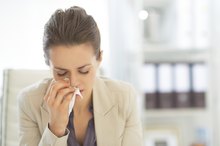A Pollen Allergy: Symptoms of a Sore Throat
A sore throat is discomfort, pain or swelling in the throat, according to MedlinePlus. A pollen allergy causes the hormone, histamine, to be released in the body, causing inflammation and irritation in the throat. Once the throat swells, it becomes increasingly sensitive and agitated. The best treatment for a sore throat from a pollen allergy is to avoid pollen exposure and treat the allergic reaction with an antihistamine, according to National Jewish Health. If a sore throat persists, seek medical advice, as it may be sign of a more serious condition. Begin treating a sore throat at the first signs and symptoms.
If you are experiencing serious medical symptoms, seek emergency treatment immediately.
Throat Discomfort
Throat discomfort is the most common symptom of a sore throat from a pollen allergy, according to the Eyes, Nose and Throat Specialists of Corpus Christi. The throat is irritated by the allergen, creating a scratchy feeling. If left untreated, the throat can become swollen, affecting a person’s ability to swallow food and saliva. The discomfort can turn to pain and affect the voice box. Throat irritation from a pollen allergy can leave the throat susceptible to a secondary infection, such as strep throat, according to MedlinePlus.
- Throat discomfort is the most common symptom of a sore throat from a pollen allergy, according to the Eyes, Nose and Throat Specialists of Corpus Christi.
- Throat irritation from a pollen allergy can leave the throat susceptible to a secondary infection, such as strep throat, according to MedlinePlus.
Postnasal Drip
Allergies & Trouble Swallowing
Learn More
Postnasal drip is a common symptom of a pollen allergy, according to the American Academy of Otolaryngology 1. A pollen allergy causes the sinuses to overproduce mucus, leading to excessive drainage in the back of the throat. The mucus can accumulate, causing throat irritation. If the mucus remains in the throat for an extended period of time, it can encourage the growth of bacteria, leading to an infection. If a sore throat is accompanied with thick, dark yellow-colored mucus, talk with a doctor. This may be a sign of a secondary infection.
- Postnasal drip is a common symptom of a pollen allergy, according to the American Academy of Otolaryngology 1.
- A pollen allergy causes the sinuses to overproduce mucus, leading to excessive drainage in the back of the throat.
Hoarseness and Wheezing
A sore throat from a pollen allergy can lead to hoarseness and wheezing, according to MedlinePlus. As the throat becomes increasingly irritated, the larynx, or the voice box, is directly affected, causing hoarseness. Hoarseness is characterized by a scratchy voice and the inability of the sufferer to make clear and precise sounds. Wheezing may develop as a result of a sore throat from a pollen allergy. This can be a combination of throat irritation and asthmatic reactions. Wheezing is a high-pitched sound made by restriction in the airways. If wheezing is combined with restriction in breathing, the individual should seek medical attention.
- A sore throat from a pollen allergy can lead to hoarseness and wheezing, according to MedlinePlus.
Related Articles
References
- American Academy of Otolaryngology: Post-Nasal Drip
- Omaña-cepeda C, Martínez-valverde A, Del mar sabater-recolons M, Jané-salas E, Marí-roig A, López-lópez J. A literature review and case report of hand, foot and mouth disease in an immunocompetent adult. BMC Res Notes. 2016;9:165. doi:10.1186/s13104-016-1973-y
- American Academy of Otolaryngology—Head and Neck Surgery. Sore Throats. Updated August 2018.
- American Academy of Pediatrics. When a Sore Throat is a More Serious Infection. Updated June 5, 2018
- American Academy of Family Physicians. Sore Throat Overview. Updated August 2018.
Writer Bio
Diane Marks started her writing career in 2010 and has been in health care administration for more than 30 years. She holds a registered nurse license from Citizens General Hospital School of Nursing, a Bachelor of Arts in health care education from California University of Pennsylvania and a Master of Science in health administration from the University of Pittsburgh.








